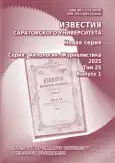Том 25, № 1 (2025)
Лингвистика
Сложность как текстовая, языковая и метаязыковая категория
Аннотация
 1-14
1-14


Вариативность жанра автобиографического рассказа в диалектной и литературно-разговорной речи (на материале Саратовского диалектологического корпуса)
Аннотация
 15-23
15-23


Обращения супругов к их родителям на основе отношений по свойству в русской культуре
Аннотация
 24-33
24-33


Особенности отображения речевого портрета ребенка-аутиста в переводе на русский язык романа Марка Хэддона «Загадочное ночное убийство собаки»
Аннотация
Представленная статья затрагивает проблему изучения речевой характеристики в целом, в особенности характеристики персонажа литературного произведения, что вызывает в последнее время большой интерес. Речевой портрет литературного героя является одним из ключевых компонентов формирования образа в художественном тексте. Однако изучению речи персонажа-ребенка, тем более с особенностями развития, уделялось не так много внимания. Источником материала исследования послужил современный англоязычный роман Марка Хэддона (Mark Haddon) «The Curious Incident of the Dog in the Night-Time» (2003) и его перевод на русский язык, выполненный А. Куклей («Загадочное ночное убийство собаки», 2003). Основная цель работы связана с перечислением, классификацией и анализом особенностей сложного речевого портрета ребенка, у которого наблюдается расстройство аутистического спектра, а также анализом способов перевода этих особенностей. Исследование опирается на классификацию, согласно которой основу для исследований в области аутизма составляют нарушения социализации, коммуникации и воображения. Избранная автором методология, которая базируется на применении метода сплошной выборки, метода классификации, метода сопоставительного анализа, количественного метода, позволила прийти к ряду выводов и наблюдений. Так, автор считает, что большинство речевых особенностей, присущих подростку с аутизмом, сохраняются в тексте перевода. Переводчик, по мнению автора, внимательно передает эти особенности на другой язык, иногда внося изменения с учетом контекста, нюансов языковой структуры и культурных особенностей, что требует определенных адаптаций для более точной передачи смысла и эмоций.
 34-39
34-39


Взаимодействие религиозного, исторического и художественного дискурсов в массмедиа
Аннотация
 40-46
40-46


Синхронно-диахронный анализ тематической группы «Сверхъестественные существа в религиозных культурах» (на материале русского языка)
Аннотация
 47-56
47-56


Литературоведение
Кипарис у пещеры: эротическая фрустрация, агон и смерть в XI идиллии Феокрита
Аннотация
 57-66
57-66


Сказка о «Спящей красавице» Ш. Перро в зеркале либретто И. А. Всеволожского и М. Петипа
Аннотация
 67-75
67-75


Письма З. Н. Гиппиус в дневниковом дискурсе С. П. Каблукова
Аннотация
 76-84
76-84


Инсективная символика в творчестве Б. Поплавского: цикады и кузнечики
Аннотация
 85-91
85-91


Трагическая диалектика жизни детей с тиверзинского двора в романе Б. Л. Пастернака «Доктор Живаго»
Аннотация
 92-98
92-98


Влияние русской сатиры на дунганскую сатирическую прозу в Центральной Азии
Аннотация
 99-103
99-103


Фольклорно-мифологическая основа женского квеста в русскоязычном романе-фэнтези: к постановке проблемы
Аннотация
 104-109
104-109


Журналистика
Культура речи журналиста в эпоху медиатизации коммуникации
Аннотация
 110-116
110-116


Хроника научной жизни
XXII Международная научная конференция «Ономастика Поволжья»
Аннотация
 117-120
117-120












